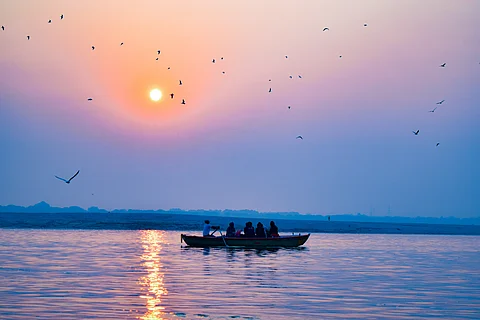
- Destinations
- Experiences
- Stay
- What's new
- Celebrating People
- Responsible Tourism
- CampaignsCampaigns
- Subscribe
- Buy Now

Uttar Pradesh has long grappled with the challenge of keeping its rivers clean. In early 2025, the National Green Tribunal (NGT) once again reprimanded the state government for failing to stem pollution in the Hindon River, citing unchecked industrial effluents, untreated sewage, and solid waste choking both the river and its tributaries.
In November 2024, the NGT had also noted the worsening water quality of the Ganga in the state, primarily due to the persistent discharge of sewage and sullage. Now, as part of the Namami Gange programme, 50 dried up or endangered rivers—spanning a total length of 3,363 km—are being revived across the state, contributing significantly to ecological restoration and the improvement of rural livelihoods. Rivers undergoing revival include the Noon in Kanpur, Kukrail in Lucknow, Tilodki in Ayodhya, Pili in Jaunpur, and Belan in Sonbhadra.
The campaign has led to the restoration of small rivers and seasonal streams across 1,011 Ganga Gram Panchayats. This effort has involved clearing silted channels, removing encroachments, and enabling the natural flow of water. Groundwater levels in several affected areas have shown marked improvement, easing water scarcity and helping farmers access more reliable irrigation.
In parallel, 86 river-related projects have been executed under MGNREGA. These include desilting works, embankment strengthening, river deepening, watershed development, and stream restoration—all geared towards enhancing long-term water retention and flood prevention.
Authorities say that afforestation has played a key role in this environmental push. Plantation drives at 894 designated sites, particularly along riverbanks, are helping stabilise soil, reinforce embankments, and support local biodiversity. These vegetated buffer zones are expected to bolster climate resilience and deliver broader ecological benefits over time.
The campaign has also seen the construction and reinforcement of 3,388 ponds across rural Uttar Pradesh. These multipurpose water bodies support irrigation, livestock, and access to drinking water—providing vital relief to communities facing seasonal drought or chronic water stress.
Whether these efforts will endure remains an open question. For all the energy invested in reviving rivers once choked by neglect, the deeper challenge lies not only in infrastructure or policy, but in mindset. In a country where rivers are worshipped yet routinely polluted, the contradiction is stark.
True rejuvenation will depend not just on government-led campaigns, but on whether communities can reimagine their relationship with water—not as something to be exploited or forgotten, but as a living presence that sustains, connects, and reflects them. If that shift takes root, then perhaps the rivers will not merely be restored, but truly cared for.
